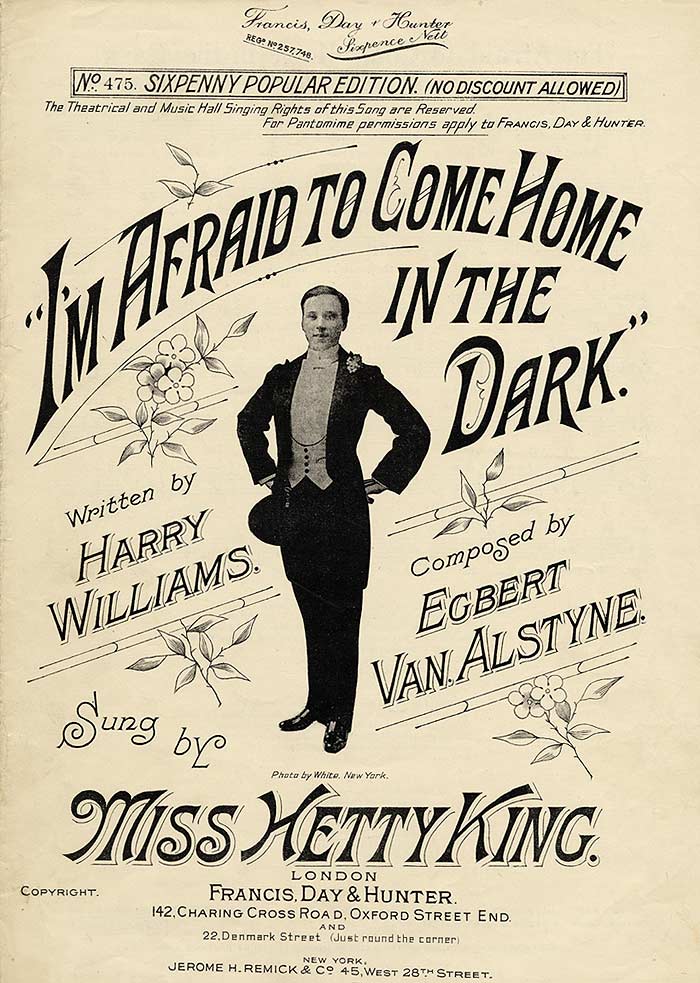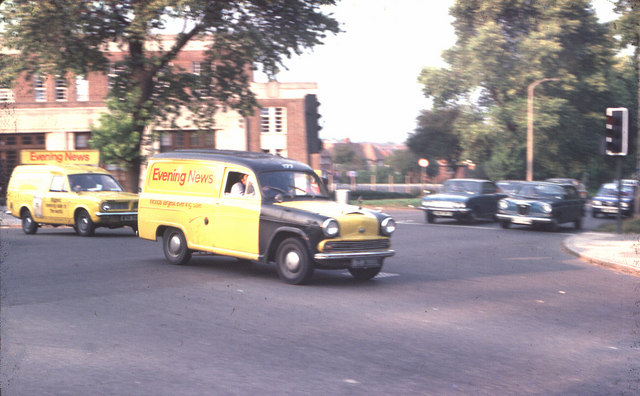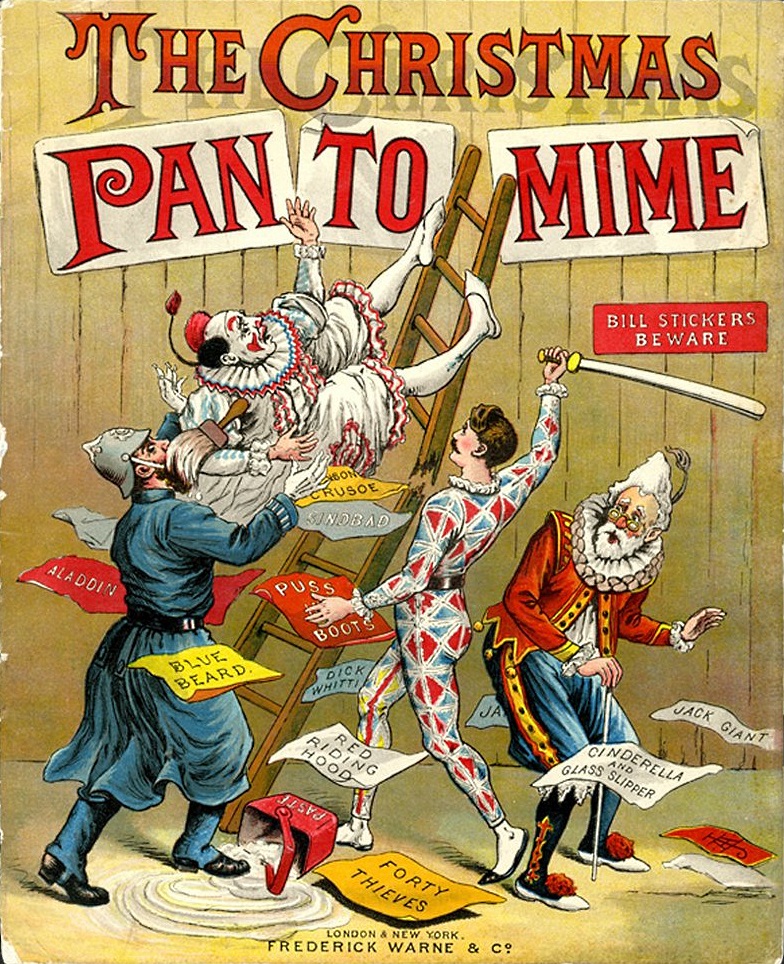|
Hetty King
Winifred Emms (4 April 1883 – 28 September 1972), best known by her stage name Hetty King, was an English entertainer who performed in the music halls as a male impersonator over some 70 years. Early life She was born in New Brighton, Cheshire, where her itinerant family were living temporarily; they were usually based in Manchester. Her father, William Emms (1856–1954), was a comedian and musician who performed as Billy King and ran Uncle Billy's Minstrels, a troupe who constantly travelled around the country with a portable theatre and caravans. As a child, she began appearing in her father's shows, imitating popular performers of the day. She adopted the name Hetty King when she first appeared on the stage of the Shoreditch Theatre, at the age of six. Career King started performing as a solo act in music halls in around 1902, doing impersonations of such stars as Gus Elen and Vesta Victoria. In her early career, she perfected an impression of the successful ''li ... [...More Info...] [...Related Items...] OR: [Wikipedia] [Google] [Baidu] |
New Brighton, Merseyside
New Brighton is a seaside resort in Wallasey, Merseyside, England, at the northeastern tip of the Wirral peninsula. It has sandy beaches which line the Irish Sea and mouth of the Mersey, and the UK's longest promenade. At the 2011 Census, the population was 14,859. History Up to the nineteenth century, the area had a reputation for smuggling and wrecking, and secret underground cellars and tunnels are still rumoured to exist. It also had a strategic position at the entrance to the Mersey Estuary. The Perch Rock battery was completed in 1829. It mounted 18 guns, mostly 32-pounders, with 3 6-inch guns installed in 1899. Originally cut off at high tide, coastal reclamation has since made it fully accessible. In 1830, a Liverpool merchant, James Atherton, purchased of land at Rock Point, which enjoyed views out to sea and across the Mersey and had a good beach. His aim was to develop it as a desirable residential and watering place for the gentry, in a similar way to ... [...More Info...] [...Related Items...] OR: [Wikipedia] [Google] [Baidu] |
Dick Whittington
Richard Whittington (c. 1354–1423) of the parish of St Michael Paternoster Royal, City of London, was an English merchant and a politician of the late medieval period. He is also the real-life inspiration for the English folk tale ''Dick Whittington and His Cat''. He was four times (appointed once, elected three times) Lord Mayor of London, a member of parliament and a Sheriff of London. In his lifetime he financed a number of public projects, such as drainage systems in poor areas of medieval London, and a hospital ward for unmarried mothers. He bequeathed his fortune to form the Charity of Sir Richard Whittington which, nearly 600 years later, continues to assist people in need. Origins He was born, in around the early 1350s, into an ancient and wealthy Gloucestershire gentry family. The 3rd son of Sir William Whittington (d.1358) of Pauntley, in the Forest of Dean, Gloucestershire, a Member of Parliament, by his wife Joan Maunsell, a daughter of William Maunsell (or ... [...More Info...] [...Related Items...] OR: [Wikipedia] [Google] [Baidu] |
Hampton Court
Hampton Court Palace is a Grade I listed royal palace in the London Borough of Richmond upon Thames, southwest and upstream of central London on the River Thames. The building of the palace began in 1514 for Cardinal Thomas Wolsey, the chief minister of Henry VIII. In 1529, as Wolsey fell from favour, the cardinal gave the palace to the king to check his disgrace. The palace went on to become one of Henry's most favoured residences; soon after acquiring the property, he arranged for it to be enlarged so that it might more easily accommodate his sizeable retinue of courtiers. Along with St James' Palace, it is one of only two surviving palaces out of the many the king owned. The palace is currently in the possession of King Charles III and the Crown. In the following century, King William III's massive rebuilding and expansion work, which was intended to rival the Palace of Versailles, destroyed much of the Tudor palace.Dynes, p. 90. His work ceased in 1694, leaving the pala ... [...More Info...] [...Related Items...] OR: [Wikipedia] [Google] [Baidu] |
The Evening News (London Newspaper)
The ''Evening News'', earlier styled as ''The Evening News'', and from 1889 to 1894 The Evening News and Post, was an evening newspaper published in London from 1881 to 1980, reappearing briefly in 1987. It became highly popular under the control of the Harmsworth brothers. For a long time it maintained the largest daily sale of any evening newspaper in London. After financial struggles and falling sales, it was eventually merged with its long-time rival the ''Evening Standard'' in 1980. The newspaper was revived for an eight-month period in 1987. Early history The newspaper was founded by Coleridge Kennard and Harry Marks. The first issue appeared on 26 July 1881. It was the first popular evening paper in London. It was priced at one halfpenny, distinguishing itself from the more serious penny papers such as ''The Times''. The first issues were printed on light blue paper, and later editions on yellow and green paper. The rivalry between halfpenny papers in the late 19th cen ... [...More Info...] [...Related Items...] OR: [Wikipedia] [Google] [Baidu] |
World War I
World War I (28 July 1914 11 November 1918), often abbreviated as WWI, was List of wars and anthropogenic disasters by death toll, one of the deadliest global conflicts in history. Belligerents included much of Europe, the Russian Empire, the United States, and the Ottoman Empire, with fighting occurring throughout Europe, the Middle East, Africa, the Pacific Ocean, Pacific, and parts of Asia. An estimated 9 million soldiers were killed in combat, plus another 23 million wounded, while 5 million civilians died as a result of military action, hunger, and disease. Millions more died in Genocides in history (World War I through World War II), genocides within the Ottoman Empire and in the Spanish flu, 1918 influenza pandemic, which was exacerbated by the movement of combatants during the war. Prior to 1914, the European great powers were divided between the Triple Entente (comprising French Third Republic, France, Russia, and British Empire, Britain) and the Triple A ... [...More Info...] [...Related Items...] OR: [Wikipedia] [Google] [Baidu] |
Signature Song
A signature (; from la, signare, "to sign") is a Handwriting, handwritten (and often Stylization, stylized) depiction of someone's name, nickname, or even a simple "X" or other mark that a person writes on documents as a proof of identity and intent. The writer of a signature is a signatory or signer. Similar to a handwritten signature, a signature work describes the work as readily identifying its creator. A signature may be confused with an autograph, which is chiefly an artistic signature. This can lead to confusion when people have both an autograph and signature and as such some people in the public eye keep their signatures private whilst fully publishing their autograph. Function and types The traditional function of a signature is to permanently affix to a document a person's uniquely personal, undeniable self-identification as physical evidence of that person's personal witness and certification of the content of all, or a specified part, of the document. For examp ... [...More Info...] [...Related Items...] OR: [Wikipedia] [Google] [Baidu] |
Pantomime
Pantomime (; informally panto) is a type of musical comedy stage production designed for family entertainment. It was developed in England and is performed throughout the United Kingdom, Ireland and (to a lesser extent) in other English-speaking countries, especially during the Christmas and New Year season. Modern pantomime includes songs, gags, slapstick comedy and dancing. It employs gender-crossing actors and combines topical humour with a story more or less based on a well-known fairy tale, fable or folk tale.Reid-Walsh, Jacqueline. "Pantomime", ''The Oxford Encyclopedia of Children's Literature'', Jack Zipes (ed.), Oxford University Press (2006), Pantomime is a participatory form of theatre, in which the audience is encouraged and expected to sing along with certain parts of the music and shout out phrases to the performers. Pantomime has a long theatrical history in Western culture dating back to the era of classical theatre. It developed partly from the 16th century ... [...More Info...] [...Related Items...] OR: [Wikipedia] [Google] [Baidu] |
Liverpool Empire
The Liverpool Empire Theatre is a theatre on the corner of Lime Street in Liverpool, England. The playhouse, which opened in 1925, is the second one to be built on the site. It has the largest two-tier auditorium in the United Kingdom and can seat 2,348 people. History The site's first theatre, which was at that time was Liverpool's largest, was named the "New Prince of Wales Theatre and Opera House" opened on 15 October 1866. On 29 July 1867 its name was changed to the "Royal Alexandra Theatre and Opera House" in honour of Princess Alexandra, Princess of Wales. In 1894, the playhouse closed but was re-opened the following year under the ownership of Empire Theatre (Liverpool) Ltd. In 1896 the theatre was sold to Messrs. Moss and Thornton for £30,000 (), and renamed "The Empire". It closed for the final time on 16 February 1924, and was demolished. The current Liverpool Empire Theatre opened on 9 March 1925. In 1977 the theatre was still owned by Moss Empires, who were makin ... [...More Info...] [...Related Items...] OR: [Wikipedia] [Google] [Baidu] |
Bennett Scott
Bennett Scott (12 October 1871 – 1 June 1930)Richard Anthony Baker, ''British Music Hall: an illustrated history'', Pen & Sword, 2014, , pp.154-156 was an English writer of music hall songs. Born in London, of Jewish background, he started working in warehouses, but in 1894 advertised his services as a provider of "good songs and catchy melodies... at a guinea a time." His first major success came with "I've Made Up My Mind to Sail Away" (1902), sung by Tom Costello. He established a working partnership with fellow songwriter A. J. Mills. They set up the Star Music Company, and together wrote "By the Side of the Zuider Zee" (1906, performed by Fanny Fields); "Ship Ahoy! (All the Nice Girls Love a Sailor)" (1908, performed by Hetty King), "Fall In and Follow Me" (1910, performed by Whit Cunliffe), "When I Take My Morning Promenade" (1912, performed by Marie Lloyd), and " Take Me Back to Dear Old Blighty" (1916, performed by Florrie Forde Flora May Augusta Flannagan ... [...More Info...] [...Related Items...] OR: [Wikipedia] [Google] [Baidu] |
Ship Ahoy! (All The Nice Girls Love A Sailor)
"Ship Ahoy! (All the Nice Girls Love a Sailor)" is an English music hall song from 1908, written by Bennett Scott and A. J. Mills of the Star music publishing company in London. Some sources credit Scott alone; others additionally credit their colleague Fred Godfrey. The song was first performed by male impersonator Hetty King. She later said that she first sang it at the Liverpool Empire in 1908, but it did not become successful until 1909, when it became popular and, towards the end of the year, was described as the greatest pantomime hit for four years. The song stayed in King's repertoire for the rest of her life, and has remained popular.Richard Anthony Baker, ''British Music Hall: an illustrated history'', pp.154-155 It was first recorded in 1910, by Ella Retford. The words of the chorus are: [...More Info...] [...Related Items...] OR: [Wikipedia] [Google] [Baidu] |
Piccadilly
Piccadilly () is a road in the City of Westminster, London, to the south of Mayfair, between Hyde Park Corner in the west and Piccadilly Circus in the east. It is part of the A4 road that connects central London to Hammersmith, Earl's Court, Heathrow Airport and the M4 motorway westward. St James's is to the south of the eastern section, while the western section is built up only on the northern side. Piccadilly is just under in length, and it is one of the widest and straightest streets in central London. The street has been a main thoroughfare since at least medieval times, and in the Middle Ages was known as "the road to Reading" or "the way from Colnbrook". Around 1611 or 1612, a Robert Baker acquired land in the area, and prospered by making and selling piccadills. Shortly after purchasing the land, he enclosed it and erected several dwellings, including his home, Pikadilly Hall. What is now Piccadilly was named Portugal Street in 1663 after Catherine of Bragan ... [...More Info...] [...Related Items...] OR: [Wikipedia] [Google] [Baidu] |
Gibson Girl
The Gibson Girl was the personification of the feminine ideal of physical attractiveness as portrayed by the pen-and-ink illustrations of artist Charles Dana Gibson during a 20-year period that spanned the late 19th and early 20th centuries in the United States. The artist saw his creation as representing the composite of "thousands of American girls". Image The Gibson Girl image that appeared in the 1890s combined elements of older American images of contemporary female beauty, such as the "fragile lady" and the "voluptuous woman". From the "fragile lady" she took the basic slender lines, and a sense of respectability. From the "voluptuous woman" she took a large bust and hips, but was not vulgar or lewd, as previous images of women with large busts and hips had been depicted. From this combination emerged the Gibson Girl, who was tall and slender, yet with ample bosom, hips and buttocks. She had an exaggerated S-curve torso shape achieved by wearing a swan-bill corset. Image ... [...More Info...] [...Related Items...] OR: [Wikipedia] [Google] [Baidu] |





